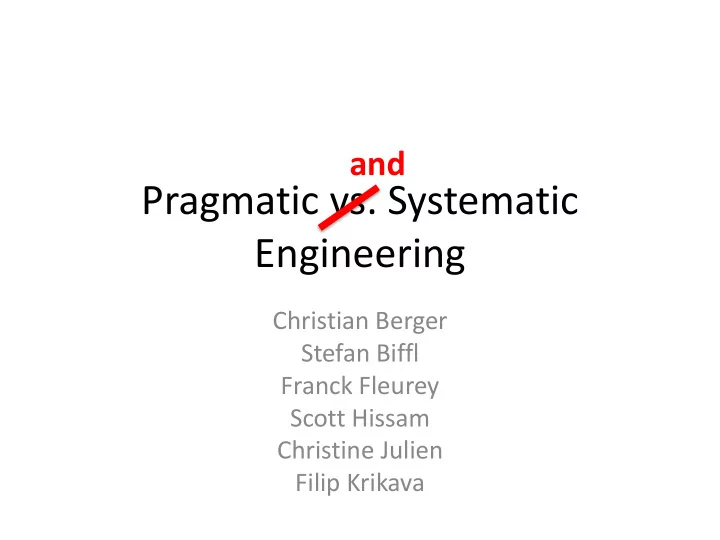

and Pragmatic vs. Systematic Engineering Christian Berger Stefan Biffl Franck Fleurey Scott Hissam Christine Julien Filip Krikava
Conceptual Summary “traditional” systematic, views of software formal, engineering model-driven pragmatic, current state incremental, of the practice palatable for CPS
Conceptual Summary “mission critical” systematic, systems formal, model-driven pragmatic, “maker” systems, incremental, Internet of Things palatable
The “Pure” Perspectives • In “traditional” software engineering, we usually have the goal of abstraction – CPS may require balancing this goal with meeting domain experts “at their level” • From a “purist” perspective, we need: – A clear, complete high- level description and a “compiler” that can generate correct code – Domain specific languages offer a first step • i.e., they make it possible to specify a solution and generate code automatically – But generated code is often “not efficient enough”
The Mismatch • There is a key interdisciplinary problem – i.e., a “mismatch” in the languages spoken by the software engineers and the domain experts • Often what happens is the domain experts build a system – When they’re desperate, they call in a software engineer to try to find the problem – The software engineer has to become immersed in the domain • Recent anecdotal efforts hint at interdisciplinary teams that start with domain experts and software engineers
A Continuum of Systems • There are different categories of systems – Mission critical ones may require a rigorous approach from the outset – However, more “user” level systems (e.g., in the IoT , “maker” systems, etc.) may not • Systems are almost universally made up of components – There is a danger in the components being used for something unintended later
Some Directions • Can we leverage system “smarts” to aid in high quality systems? – Maybe it’s ok for the system to have flaws, as long as it has the smarts necessary to recover or repair itself • Can we derive models that are inherently composable? – We can then model components of a CPS that it is necessary to model and perhaps not others – Individual models may then be more tractable – “Connectors” across models could account for consistency, timing, security, etc.
Some More Directions • We need to improve design-time techniques and make them accessible to domain experts – However, we may also want to do some of the checking at run-time using real world data – Design-time checking will necessarily be more open
A Caveat • We are not going to replace the domain experts – The domain expert needs to be able to rely on tools to introspect expressively • Provable correctness (even at the component level) • Testing in the your environment (i.e., a well-defined test suite) – relationship to “certifiable” components • Smartness and self-adaptation – How do we make the domain experts trust the tools? • Time? Mixed teams? Technology transfer? • Evidence
Recommend
More recommend